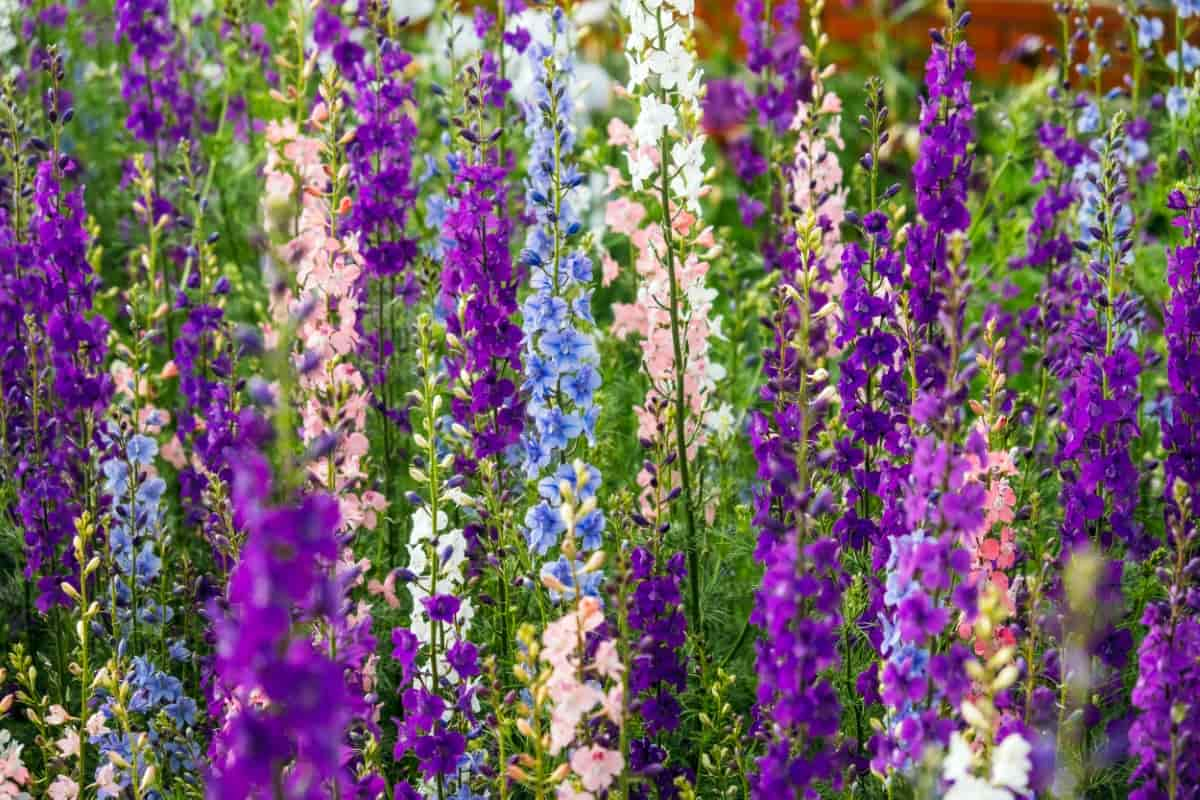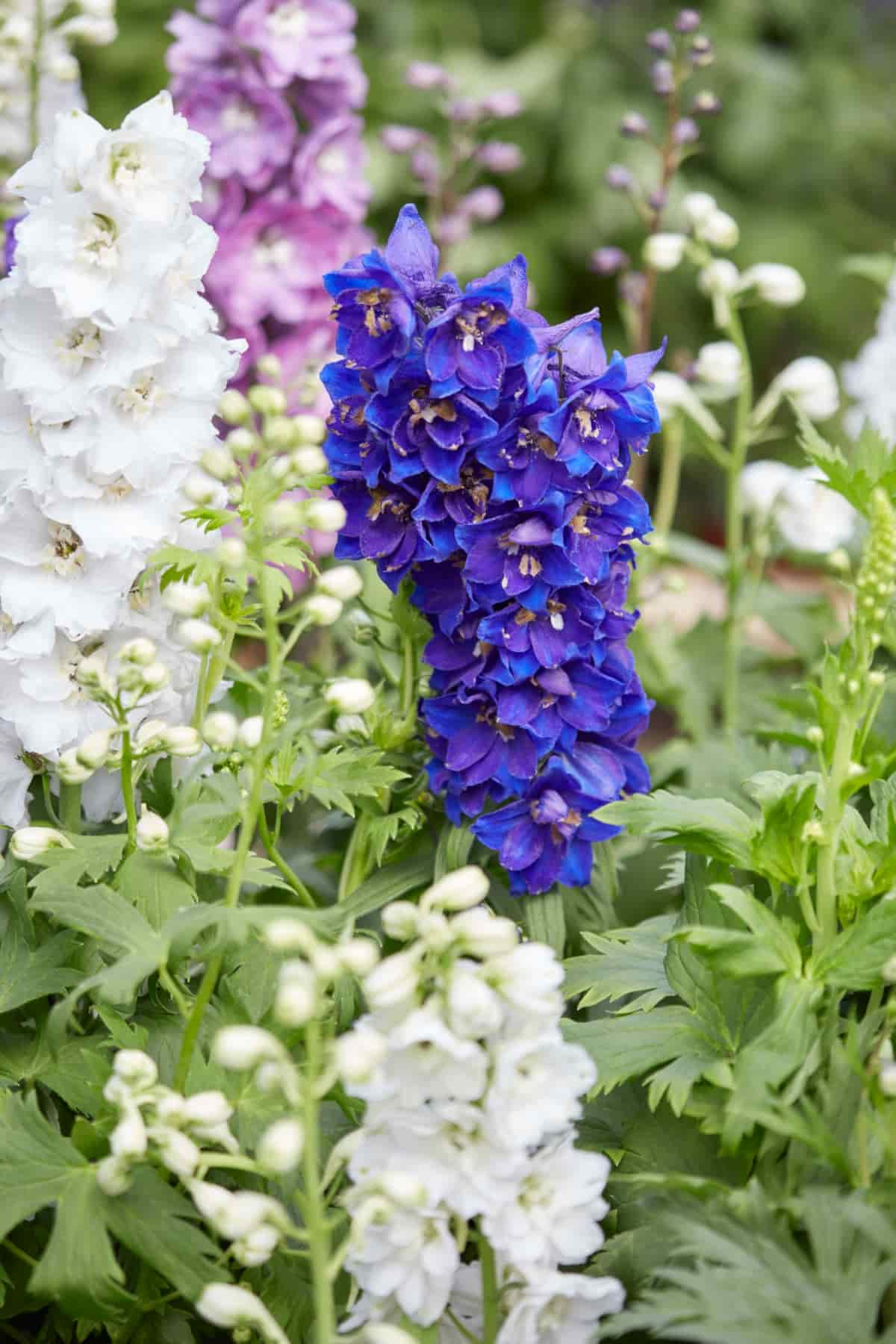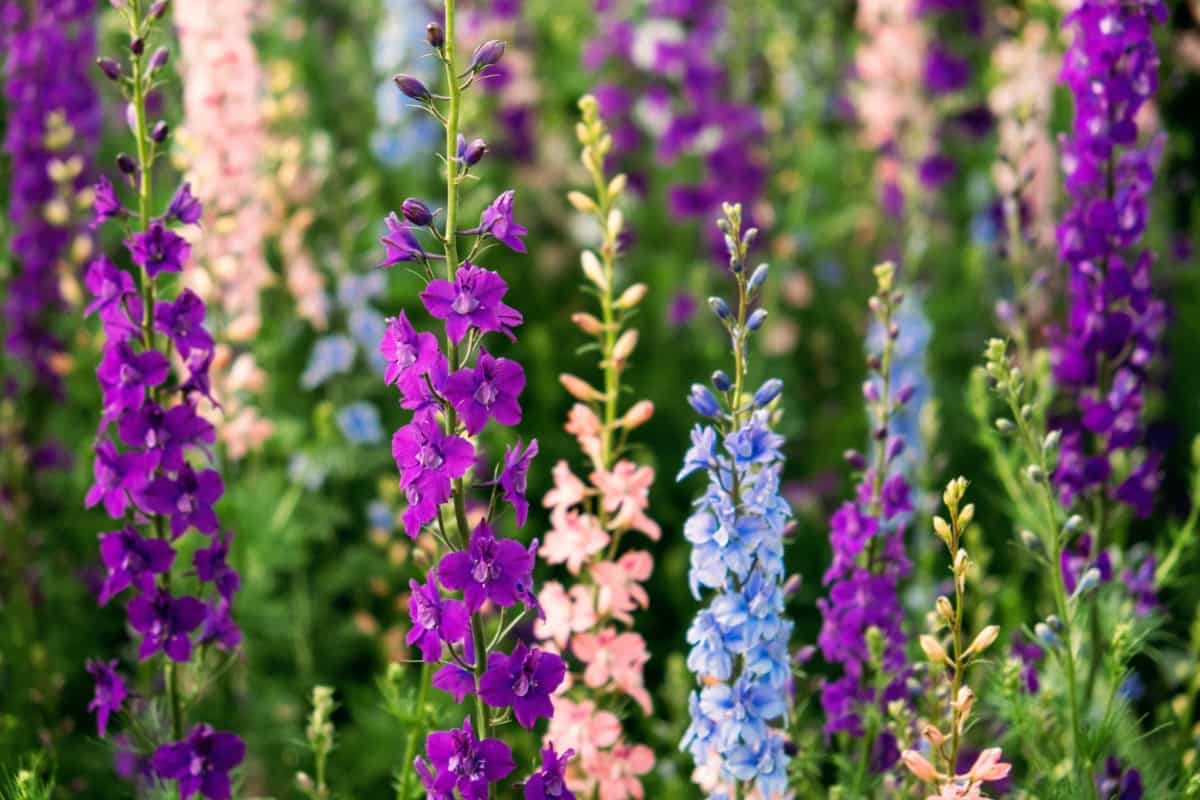A gardening journey is filled with wonder, exploration, and deep satisfaction. There’s nothing quite like the sensation of the soil in your hands, the thrill of seeing your first sprouts break through the surface, or the joy of witnessing a blossom unfurl in the sunlight. The larkspur flower, a classic choice among gardening enthusiasts, is a spectacular addition to any garden with its towering stems and vibrant, clustered blossoms.

As beginner gardeners, you might perceive growing larkspur as challenging. Still, armed with the right knowledge and a dash of patience, you can certainly grow these captivating blooms in your backyard.
How to Grow and Care for Larkspur
Choosing the Right Location and Soil for Larkspur Flowers
Selecting the optimal spot in your garden for your larkspur flowers is pivotal to their growth and survival. Larkspurs flourish in full sunlight, requiring a minimum of six hours of direct exposure daily. Partial shade may also work but could result in less vigorous plants. Ensure you pick a spot with good air circulation to prevent fungal diseases.
In terms of soil, larkspurs prefer rich, well-draining soil. Heavy clay or sandy soil might not fit these flowers best. The soil’s pH level is also essential; aim for slightly alkaline soil (pH 6.5-7.5). Should your soil exhibit excessive acidity, it may be beneficial to incorporate garden lime to elevate the pH. However, exercise caution as over-liming could detrimentally affect your plants.
Preparation and Tips for Sowing Larkspur Seeds
Sowing larkspur seeds might sound intimidating, but once you understand the basics, it’s as simple as pie. Start by preparing the soil. Ensure the removal of rocks or detritus and fracture any compact soil clusters. A useful guideline for novices is to ready the ground approximately two weeks prior to the final frost, allowing adequate time for stabilization before seed planting.
Specific to larkspur seeds, direct sowing into the soil is most beneficial due to their low transplant tolerance. Situate the seeds about 1/4 inch deep with a spacing of roughly a foot. Conceal the seeds with soil and apply a gentle watering. Larkspur seeds prefer cool temperatures for germination, so early spring or fall are the best times for sowing.
Watering Requirements and Techniques for Larkspur Plants
Like most plants, larkspur needs regular watering to flourish. However, avoiding overwatering is critical, which can lead to rotting or diseases. Water the larkspurs when the top inch of the soil feels dry. Deep watering is a recommended technique where you water the plants thoroughly, allowing the moisture to reach the deeper root zones.
Using a soaker hose or drip irrigation can be a great way to ensure that your larkspurs receive a slow, steady water supply. These methods deliver water right to the root zone, minimizing water waste and reducing the spread of diseases when water splashes onto the leaves.
Sunlight and Temperature Preferences for Larkspur Growth
Larkspur plants thrive in full sun, necessitating sites that garner a minimum of six hours of sunlight each day. However, some afternoon shade can help them keep cool in hotter regions. Regarding temperature, larkspur tolerates cooler conditions and struggles in extreme heat. They do best in moderate temperatures and might need extra care during hot summer months to prevent wilting.
Fertilizing Schedule and Methods for Healthy Larkspur Blooms
Fertilizing your larkspur plants regularly ensures they have the nutrients to produce lush growth and vibrant blooms. A balanced fertilizer with identical proportions of nitrogen, phosphorous, and potassium, is suitable for larkspurs. Fertilize your larkspurs once the plants have established and again as they bloom.
Water the plants thoroughly after each fertilizer application to help them reach the root zone and prevent potential leaf burns. Before planting, it’s advisable to incorporate a layer of compost or organic material into the soil. This will enrich the soil and improve its texture, promoting better root growth and water absorption.
Pruning and Deadheading Techniques for Larkspur Flowers
Pruning and deadheading larkspur flowers is simple but invaluable for ensuring a healthy plant. By eliminating wilted flowers, known as deadheading, you stimulate the plant to generate further blossoms, thus prolonging the flowering season. Pinch off the faded flowers with your fingers or snip them off with a pair of garden shears.
In case you missed it: How to Grow and Care for a Christmas Cactus Houseplant: Instructions for Beginners

Pruning generally involves removing dead or diseased stems and leaves to maintain plant health. It also helps maintain the plant’s shape and encourages further growth. Be sure to sterilize your tools before pruning to avoid spreading any diseases.
Identifying and Treating Common Pests and Diseases of Larkspur
Monitor larkspur plants closely for pests and diseases to ensure their health. Aphids, slugs, and snails could infest your larkspurs, and can be manually removed or treated with a mild insecticidal soap.
Fungal diseases like powdery mildew or leaf spot may develop in high humidity or excessively damp conditions. Mitigate these risks by promoting adequate air flow around your plants and applying water at their base instead of overhead. Upon detecting disease symptoms, promptly eliminate the impacted leaves and employ a fungicide if required.
Supporting and Staking Options for Tall Larkspur Varieties
Larkspur plants, particularly the taller varieties, can benefit from staking or other support to prevent them from toppling in the wind or under the weight of their blooms. Stakes or garden canes can be inserted into the ground next to the plants, and the stems gently tied to the stakes with soft garden twine. A trellis or plant netting can also serve as an effective support structure for your larkspur plants.
Overwintering and Care for Larkspur in Colder Climates
For those residing in chilly regions, additional measures are needed to ensure larkspur’s winter survival. Post the initial intense autumn frost, prune the plants to approximately 6 inches from the ground. Envelop the plants with ample mulch to shield the roots from frigid conditions. As spring arrives with warmer temperatures, remove the mulch to facilitate plant growth.
Harvesting and Preserving Larkspur Seeds for Future Planting
The cultivation of larkspurs brings the pleasure of saving and maintaining seeds for future use. Upon the flowers’ wilting and formation of seed pods, patience is required until these pods mature to a dry, brown state. Subsequently, cautiously gather and crack the pods to retrieve the seeds. Preserve these seeds in a low-humidity, cool environment until the next planting season. This method guarantees a continuous availability of larkspur seeds, thereby securing the perpetuity of your stunning larkspur garden.
In case you missed it: How to Grow and Care for Sago Palm: A Comprehensive Guide for Beginners

Conclusion
Gardening is a journey, an ever-evolving process of learning and growing. While it may seem complex at first, with time, patience, and care, you will find that growing larkspur can be a rewarding and enjoyable experience. Embrace the lessons that each step brings, from selecting the right location to pruning and disease management, as each contributes to the success of your gardening endeavor.
- Feed Your Flock for Less: Top 10 Tips to Save on Chicken Feed
- Ultimate Guide to Ossabaw Island Hog: Breeding, Raising, Diet, and Care
- Hatching Answers: The Top 10 Reasons Your Chickens Aren’t Laying Eggs
- Eggs and Economics: Breaking Down the Cost of Raising Backyard Chickens
- Defend Your Greens: Proven Methods to Keep Iguanas Out of Your Garden
- Ultimate Guide to Cinnamon Queen Chicken: A Comprehensive Guide for Beginners
- Ultimate Guide to California Tan Chicken: Breeding, Raising, Diet, Egg-Production and Care
- Ultimate Guide to Marsh Daisy Chicken: Breeding, Raising, Diet, and Care
- 10 Types of Chicken Farming Businesses You Can Start for Profits